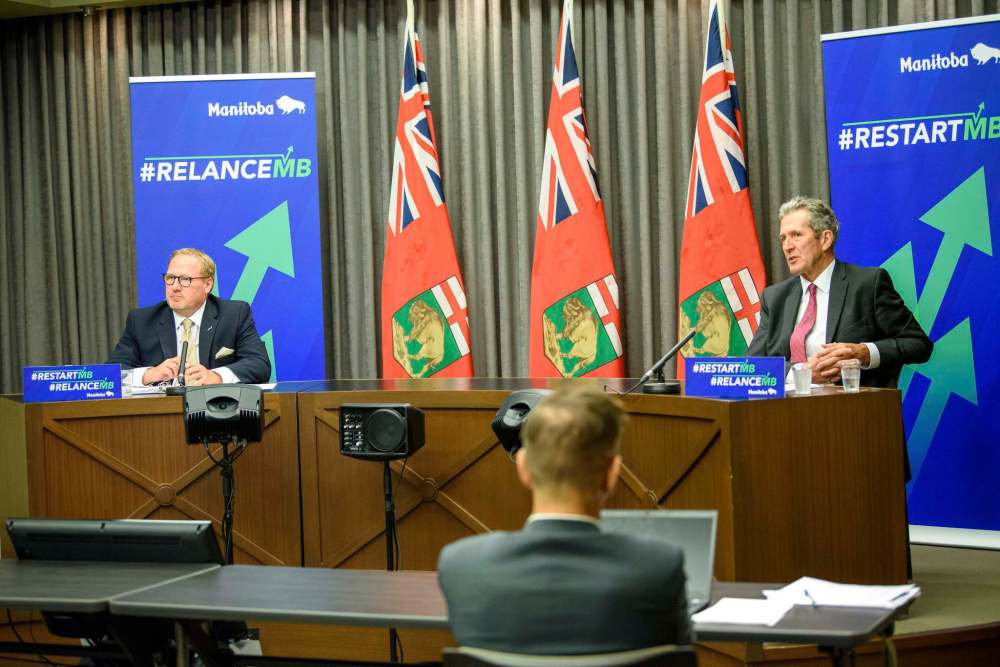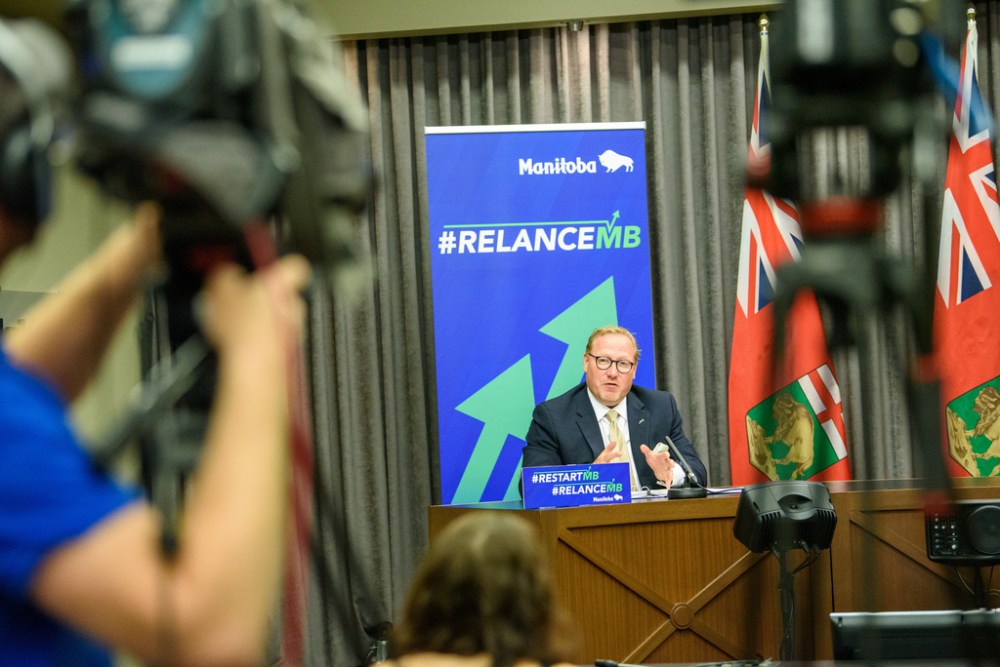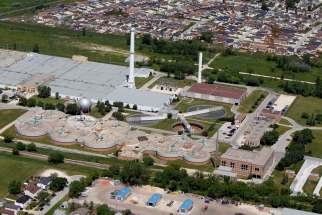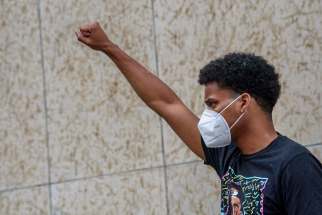Grim fiscal update predicts $2.9-B deficit
Read this article for free:
or
Already have an account? Log in here »
To continue reading, please subscribe:
Monthly Digital Subscription
$19 $0 for the first 4 weeks*
- Enjoy unlimited reading on winnipegfreepress.com
- Read the E-Edition, our digital replica newspaper
- Access News Break, our award-winning app
- Play interactive puzzles
*No charge for four weeks then billed as $19 plus GST every four weeks. Offer only available to new and qualified returning subscribers. Cancel any time.
Read unlimited articles for free today:
or
Already have an account? Log in here »
Hey there, time traveller!
This article was published 29/06/2020 (1645 days ago), so information in it may no longer be current.
Manitoba is expected to nearly triple its all-time highest deficit this year — at least.
Premier Brian Pallister and Finance Minister Scott Fielding said Tuesday if the province stays on course with its positive pandemic recovery, they’re expecting a $2.9 billion deficit — nearly three times the record deficit of $1 billion in 2011-12 following a disastrous flood.
The province released an economic and fiscal update Tuesday after COVID-19 derailed its initial March budget that planned to cut the deficit to $220 million and the provincial sales tax by one per cent.

Now, as long as Manitoba’s economic recovery continues, a $2.9 billion deficit is anticipated, Fielding said at a press conference with the premier. That number was arrived at as the “consensus forecast” based on nine bond rating agencies, banks and other economic indicators. If COVID-19 makes a comeback and there is a prolonged economic downturn, the deficit could rise to $5 billion.
As things stands, the province expects to borrow $9.5 billion, up from $5.9 billion set out in the March budget, Fielding said. And Pallister, who said the promised PST cut would be postponed until next year, isn’t so sure it will happen.
“I wouldn’t want to commit to that at this point in time,” the premier told reporters.
“Manitoba is facing an unprecedented fiscal challenge because of COVID-19,” Fielding said.
He’s expecting a $1.5 billion decline in revenue that could grow to a $3 billion loss if Manitoba’s recovery stalls and there’s a downturn.
Pallister, who staked his reputation on balancing Manitoba’s budget, said one of the ways to get the province out of the hole is to get people back to work. The province’s program offering Manitobans up to $2,000 to get off the Canada Emergency Response Benefit and back on the job is an example, he said.
“Just in the last few days we’ve already had 644 Manitobans (apply to) get off the CERB program,” Pallister said. The payment offsets the penalty they’d incur if they earned more than the $1,000 in monthly wages they’re allowed to make and still collect CERB. “As more people choose to go back to work, clearly more businesses can begin to reopen on a fuller basis.”
As it stands, Manitoba’s GDP is expected to drop five per cent this year and increase five per cent next year.
“COVID-19 is substantially increasing our expenditures and lowering revenues in 2020-21,” Fielding said. Manitoba’s total debt is projected to exceed $29 billion, with a net debt-to-GDP ratio growing to 41 per cent from 34.2 per cent in the March budget.
“Manitoba must grow its way out of this crisis,” said Fielding. “We’re making important investments to protect Manitobans from COVID-19 to help people get back to work.”
Manitoba says as a percentage of GDP, it is spending more than any other province except Quebec on its pandemic response — with $2.1 billion or 2.9 per cent of its GDP. The money is going toward infrastructure spending, health care and direct payments to individuals and businesses who will benefit from savings on taxes and fees.

The biggest chunk of that is $600 million for the Manitoba Restart capital program. That pot of money will now be used for projects including the St. Mary’s Road interchange at Highway 1 that the province had already planned to build. The second-biggest expense is $360 million for personal protective equipment (PPE) followed by $280 million for safety upgrades to personal care homes, $120 million for the risk recognition program’s one-time payment to front-line workers and $120 million for the gap protection program.
Critics say the fiscal update announced on the eve of Canada Day does little to address the economic abyss many Manitobans are facing.
“What the government put out today is all about building a narrative to justify more cuts to programs and jobs and wages,” said NDP Opposition Leader Wab Kinew. “What this government fails to understand is the number one priority right now should be healing businesses that are struggling and putting people back to work.” The fiscal update failed to mention $860 million in spending cuts in the public sector, Kinew told reporters on the legislature grounds.
“The big thing missing is a cohesive back to work plan,” said Kinew, who called the fiscal update a “missed opportunity.”
“Rather than coming up with new measures and new initiatives today that are going to help us rebound quickly, they’ve repackaged previous announcments and continue to shame people on the CERB,” said Kinew. The fiscal update should have been presented in the house where the government’s spending plan could’ve been scrutinized, he said.
“They’ve dug a six-foot hole with their cuts and with this flimsy document today they’re promising to fill it back in five feet and then they expect a pat on the back for that and they call that a restart,” said Kinew. “Meanwhile, our economy is headed for a relapse because we know that there’s still small businesses struggling and there’s still so many people out of work.”
The Liberals accused the Pallister government of “number-fudging.” The document release Tuesday rebranded $1.24-billion in spending that was going to happen anyway as COVID-19 measures, a statement by Liberal leader Dougald Lamont said.
carol.sanders@freepress.mb.ca

Carol Sanders
Legislature reporter
After 20 years of reporting on the growing diversity of people calling Manitoba home, Carol moved to the legislature bureau in early 2020.
Our newsroom depends on a growing audience of readers to power our journalism. If you are not a paid reader, please consider becoming a subscriber.
Our newsroom depends on its audience of readers to power our journalism. Thank you for your support.








